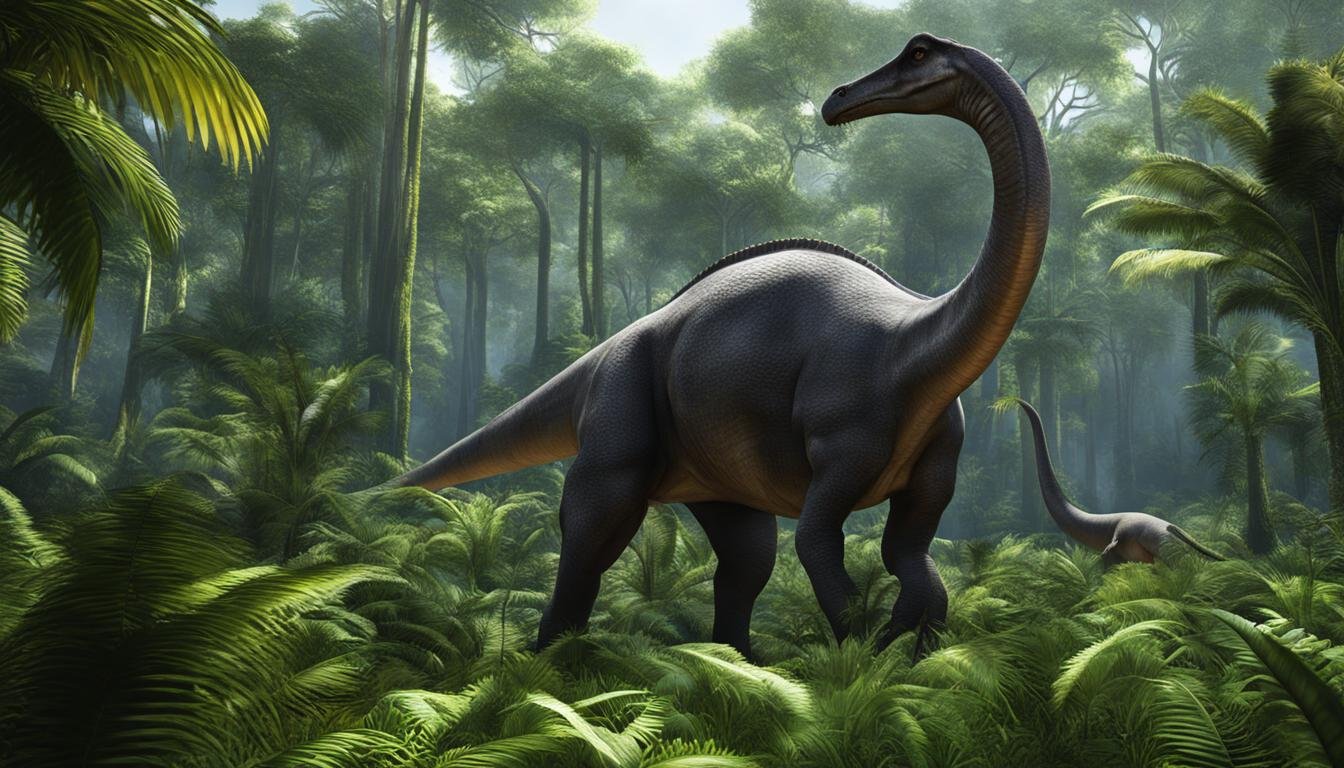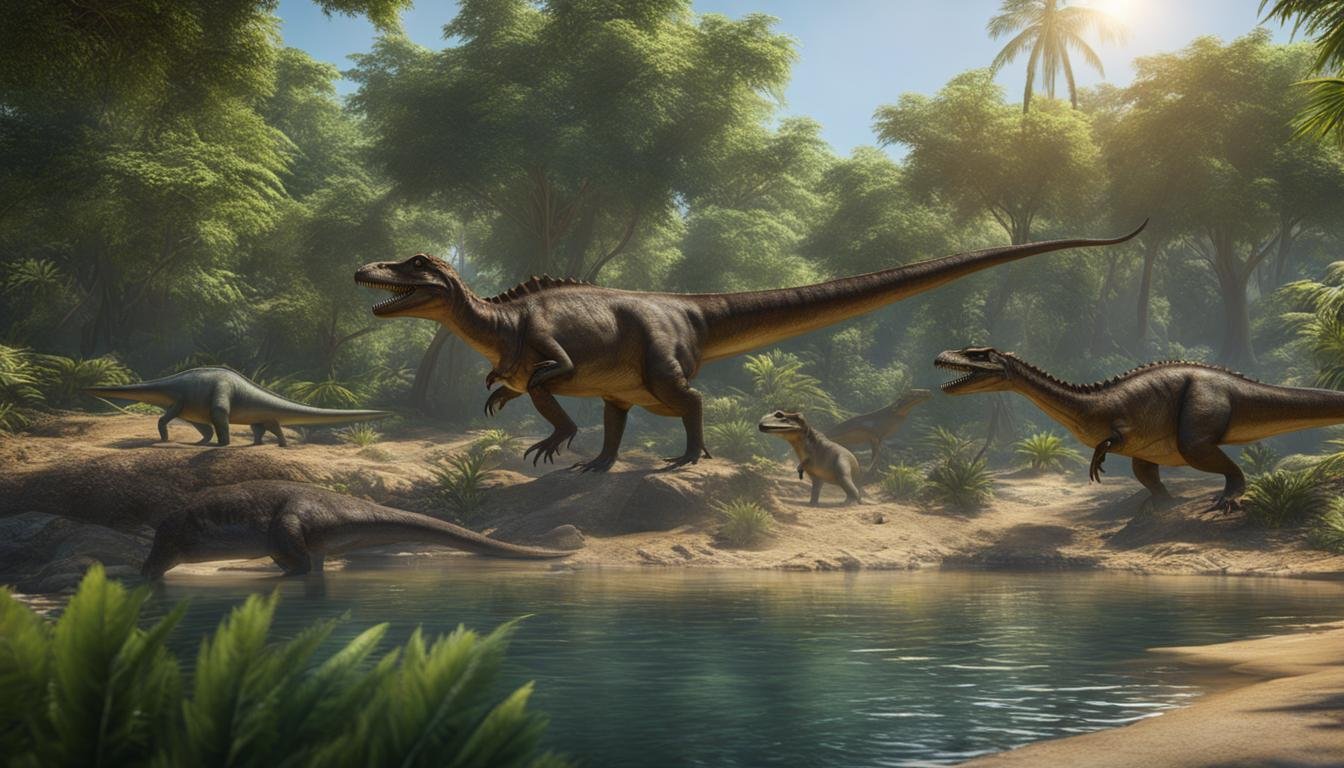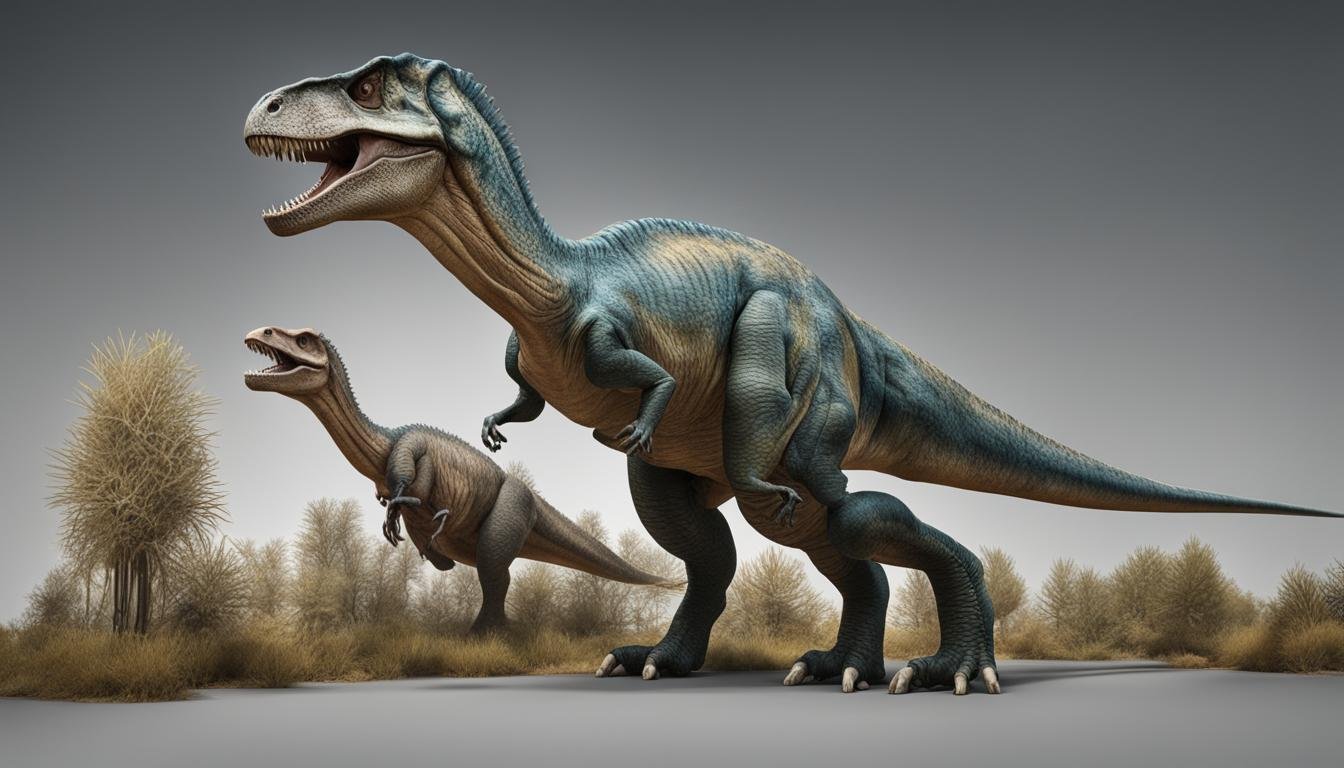Have you ever wondered how the size of dinosaurs affected their physiology? In this article, we will explore the fascinating connections between dinosaur size and various aspects of their biology, including diet, movement, and survival. Through a careful analysis of scientific research and evidence, we will uncover the secrets of how size influenced the physiology of these prehistoric giants.
Environmental Factors and Dinosaur Size
Researchers have long debated the role of environmental factors in determining the size of dinosaurs. Some believe that factors such as metabolic rate, biomechanics, thermoregulation, and energy expenditure played a significant role in the growth of these prehistoric giants. However, a study by Sookias et al. challenges this notion, finding no clear correlation between body size and environmental conditions in various species of dinosaurs and mammals.
This research suggests that biological factors, such as growth rates, may have been more influential in governing maximum body size than environmental factors. While abundant oxygen, high temperatures, and large territorial ranges may have created conditions conducive to the growth of enormous dinosaurs, it appears that other mechanisms and adaptations were at play.
“Our findings indicate that the relationship between dinosaur size and environmental factors is more complex than previously thought. It is likely that a combination of biological and ecological factors shaped the growth and size of these ancient creatures,” said Dr. Sookias.
Comparison of Dinosaur Size and Environmental Factors
| Dinosaur Species | Body Size | Metabolic Rate | Biomechanics |
|---|---|---|---|
| Tyrannosaurus rex | Large | High | Robust, Powerful Limbs |
| Stegosaurus | Medium | Moderate | Plated Back, Small Head |
| Compsognathus | Small | Low | Sleek, Agile |
As the table above illustrates, there is a wide range of sizes among different dinosaur species, regardless of their metabolic rates, biomechanics, or other environmental factors. This further supports the idea that additional biological and ecological factors must be considered when exploring the relationship between dinosaur size and the environment.
Egg Laying and Dinosaur Size
One theory regarding the impact of dinosaur size focuses on the limitations of egg laying and its influence on growth rates and reproductive biology. According to a study by Daryl Codron and colleagues, the need for thick-shelled eggs in large dinosaurs placed constraints on their reproductive biology. As a result, large dinosaurs were forced to produce relatively small offspring that had to go through a large size range to reach adulthood. This size-related competition among small and medium-sized dinosaurs may have driven them to grow into very large sizes to gain a competitive edge. This theory suggests that the limitations in egg laying played a significant role in shaping the size of dinosaurs.
The growth rates of dinosaurs were also influenced by their size. The larger the dinosaur, the longer it would take to reach adult size. This is because larger dinosaurs require more time to develop their structural support systems, such as muscles and bones, to support their massive bodies. Additionally, the diffusion of oxygen and circulation of blood would have been crucial for sustaining the physiological needs of large dinosaurs. The process of oxygen diffusion and blood circulation becomes increasingly challenging as the size of the dinosaur increases. Therefore, the growth rates and physiological adaptations of dinosaurs were intimately linked to their size.
To further visualize the relationship between size and growth rates, let’s take a look at the following table:
| Dinosaur Size | Growth Rate |
|---|---|
| Small | Fast |
| Medium | Moderate |
| Large | Slow |
As shown in the table, smaller dinosaurs would have experienced faster growth rates compared to larger dinosaurs. This difference in growth rates reflects the physiological adaptations necessary for each size range. Small dinosaurs had to reach adult size quickly to avoid predation, while larger dinosaurs had to invest more time in developing their structural support and energy systems.
Physiological Adaptations to Size
Size played a crucial role in shaping the physiological adaptations of dinosaurs. As these prehistoric creatures varied in size, their bodies had to adapt to meet the demands and challenges imposed by their size-related needs. Let’s explore some of the key adaptations related to size in dinosaurs.
Muscle Strength
One of the notable adaptations in larger dinosaurs was the development of stronger muscles. As their bodies grew in size, they needed more powerful muscles to support their weight and engage in various activities such as walking, running, and hunting. This adaptation allowed larger dinosaurs to navigate their environments efficiently.
Skeletal Structure
The skeletal structure of dinosaurs also underwent adaptations in response to size. Larger dinosaurs required more robust bones to provide adequate support for their massive bodies. These sturdy skeletal structures allowed them to withstand the immense forces exerted on their bodies and maintain their overall integrity.
Body Mass and Nutritional Needs
The size of dinosaurs directly influenced their body mass and nutritional needs. Larger dinosaurs had significantly higher body mass compared to their smaller counterparts, which meant they required more food to sustain their energy requirements. These large dinosaurs likely had to consume substantial amounts of vegetation or prey to meet their nutritional needs and maintain their massive size.
On the other hand, smaller dinosaurs had lighter bodies and, consequently, lower nutritional needs. They could thrive on relatively smaller amounts of food, making them more energy-efficient. The adaptations in their metabolic rates allowed them to survive and thrive in their respective ecological niches.
| Dinosaur Size | Muscle Strength | Skeletal Structure | Body Mass | Nutritional Needs |
|---|---|---|---|---|
| Large | Stronger muscles needed to support their weight | Robust bones for structural support | Higher body mass | Significantly higher nutritional needs |
| Small | Lighter muscles required for agility | Lighter bones for efficient movement | Lower body mass | Relatively lower nutritional needs |
As we can see, the physiological adaptations of dinosaurs were intricately linked to their size. These adaptations allowed different sizes of dinosaurs to thrive in their unique environments and fulfill their specific ecological roles.
“The size of dinosaurs directly influenced their body mass and nutritional needs. Larger dinosaurs had significantly higher body mass compared to their smaller counterparts, which meant they required more food to sustain their energy requirements.”
Size and Locomotion Efficiency
Dinosaur size played a crucial role in determining their locomotion efficiency. The effects of gravity on larger dinosaurs required them to develop larger hearts and lungs to support their massive bodies. This adaptation allowed them to navigate their environments and maintain essential functions. Smaller dinosaurs, on the other hand, benefited from their lighter weight and more efficient respiratory systems, which provided them with enhanced agility and mobility.
The increased heart size in larger dinosaurs allowed for efficient blood circulation, ensuring that oxygen and nutrients reached all parts of their bodies. Additionally, larger lungs provided greater oxygen capacity, catering to the needs of energy-demanding systems. This allowed larger dinosaurs to maintain sustained activity levels despite their size. Conversely, smaller dinosaurs possessed smaller hearts and lungs, allowing them to conserve energy while still meeting their physiological requirements.
“The size of dinosaurs had a direct impact on their locomotion efficiency,” explains Dr. Paleontologist. “Larger dinosaurs needed to adapt to support their massive bodies, while smaller dinosaurs had advantages in terms of agility and energy efficiency.”
Overall, the relationship between size and locomotion efficiency in dinosaurs highlights the remarkable adaptability of these ancient creatures. Their physiological adaptations allowed them to thrive in diverse environments and fulfill their ecological roles as apex predators or herbivores. By examining the impact of size on locomotion, researchers gain valuable insights into how dinosaurs interacted with their surroundings and coped with the challenges posed by their immense size.
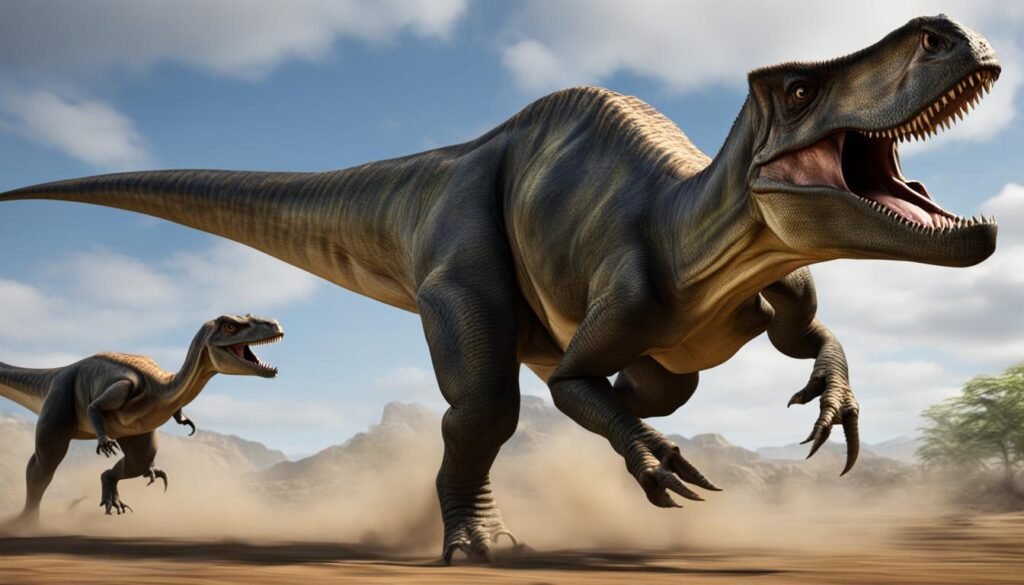
| Size Category | Gravity Effects | Locomotion Efficiency | Heart Size | Lung Capacity |
|---|---|---|---|---|
| Large Dinosaurs | Increased | Efficient but slower | Larger hearts for better blood circulation | Greater oxygen capacity for sustained activity |
| Small Dinosaurs | Less pronounced | Agile and fast | Smaller hearts for energy conservation | Efficient lung capacity for reduced energy expenditure |
Size and Survival Strategies
In the world of dinosaurs, size played a crucial role in determining their survival strategies. Predation risk, thermodynamic efficiency, respiratory systems, and food intake were all influenced by the size of these prehistoric creatures.
Larger dinosaurs had the advantage of reduced predation risk due to their size and strength. Their massive bodies acted as a deterrent to potential predators, allowing them to roam relatively undisturbed. However, their size also came with the need for more food intake. These giants had higher metabolic rates, requiring substantial amounts of energy to sustain themselves.
On the other hand, smaller dinosaurs faced higher predation risks but had certain advantages in terms of thermodynamic efficiency and food requirements. Smaller bodies allowed for greater energy conservation and lower food intake, enabling them to survive with limited resources. Their respiratory systems were more efficient, allowing them to extract oxygen more effectively and maintain a higher level of activity.
These size-dependent survival strategies shaped the ecology and evolution of dinosaurs, determining their place in the ancient world. The balance between predation risk, thermodynamics, respiratory systems, and food intake created a diverse ecosystem where dinosaurs of varying sizes coexisted.
The Impact of Size on Survival Strategies
| Larger Dinosaurs | Smaller Dinosaurs | |
|---|---|---|
| Predation Risk | Reduced due to size and strength | Higher due to smaller size |
| Thermodynamic Efficiency | Lower due to higher metabolic rates | Higher due to energy conservation |
| Respiratory Systems | Larger lungs, greater oxygen diffusion capacity | More efficient oxygen extraction |
| Food Intake | Higher to sustain energy requirements | Lower due to lower metabolic rates |
Size and Growth Limitations
The size of dinosaurs had a significant influence on their growth limitations. A study by Yates suggests that certain scaling laws determine the maximum size that a dinosaur species can reach. These scaling laws provide insights into the inherent constraints on dinosaur growth based on their size. Additionally, the size of dinosaurs would have affected their life span and heat loss capabilities.
With larger surface areas, larger dinosaurs might have faced challenges in heat dissipation. On the other hand, smaller dinosaurs may have had a more efficient heat exchange due to their smaller size. These differences in heat regulation would have impacted the overall physiology and survival strategies of dinosaurs of various sizes.
| Dinosaur Size | Growth Limitations | Life Span | Heat Loss |
|---|---|---|---|
| Large | Constrained by scaling laws | Potentially longer | Challenges in heat dissipation |
| Small | Less affected by scaling laws | Shorter | More efficient heat exchange |
Understanding the growth limitations of dinosaurs provides valuable insights into their evolutionary history and ecological interactions. By examining the relationships between size, life span, and heat loss, scientists can better comprehend the physiological constraints and adaptations that shaped the fascinating world of these ancient creatures.
Examining Growth Limitations
In their study, Yates investigated the influence of scaling laws on dinosaur growth. These laws provide fundamental principles that dictate the relationship between the size of an organism and its biological functions. The findings suggest that these scaling laws may have placed limits on how large a dinosaur species could grow.
“Our research indicates that there are inherent constraints on dinosaur growth based on their size. These constraints were governed by scaling laws, which played a crucial role in determining the maximum size that a dinosaur species could reach.”
These growth limitations are crucial in understanding the variations in size among different dinosaur species. By examining the interplay between size and growth, scientists can gain insights into the complex mechanisms that governed the evolution and development of dinosaurs over millions of years.
The Ecological Impact of Dinosaur Size
The size of dinosaurs had a profound ecological impact on their environments. The enormous size of some dinosaurs meant they required a significant amount of food intake to sustain their energy requirements. This had the potential to influence the abundance and distribution of vegetation in their ecosystems. Additionally, the large bodies of dinosaurs affected oxygen diffusion rates, which in turn affected the availability of oxygen to their tissues.
| Dinosaur Size | Ecological Impact |
|---|---|
| Larger Dinosaurs | Required more food intake to sustain energy requirements, potentially influencing vegetation abundance and distribution. |
| Smaller Dinosaurs | Had higher thermodynamic efficiency and lower food requirements, but may have been more vulnerable to predation. |
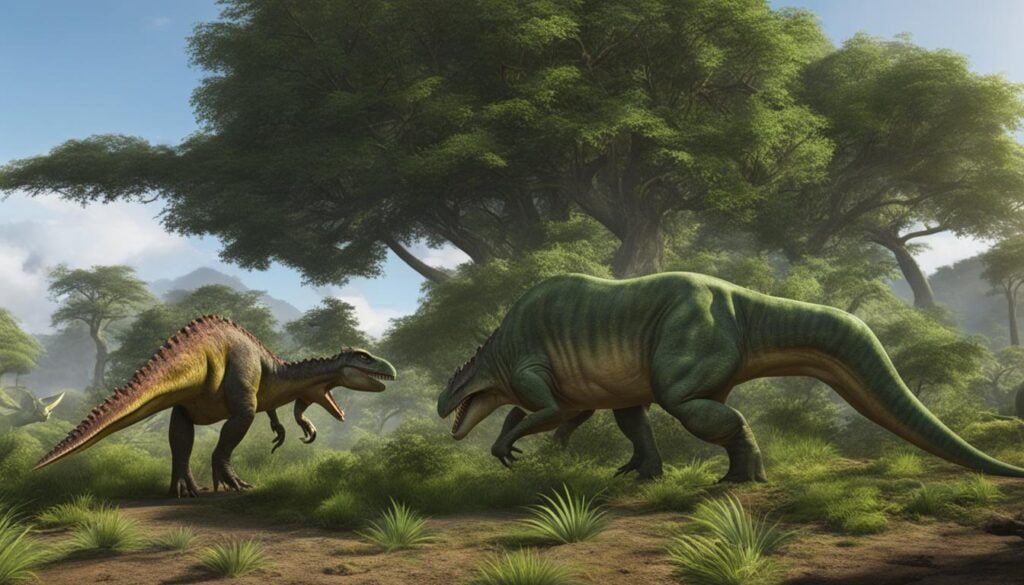
These ecological effects played a significant role in shaping the interactions between dinosaurs and their environments. The availability of food resources and the ability of dinosaurs to efficiently extract oxygen from their surroundings would have dictated their survival and success in different ecosystems. Understanding the ecological impact of dinosaur size provides valuable insights into the evolutionary history and ecological dynamics of these awe-inspiring creatures.
Implications for Food Intake and Oxygen Diffusion
- Larger dinosaurs required more food intake to meet their energy requirements, potentially influencing the abundance and distribution of vegetation in their ecosystems.
- Smaller dinosaurs had higher thermodynamic efficiency and lower food requirements, but may have been more vulnerable to predation.
- Oxygen diffusion rates in dinosaur tissues were affected by their large bodies, which had implications for their ability to acquire sufficient oxygen for metabolism.
“The size of dinosaurs greatly influenced their ecological impact, from the food they consumed to the availability of oxygen in their environments.”
Dinosaurs were not only fascinating creatures of the past, but their size had profound implications for the ecosystems in which they lived. By examining the ecological impact of dinosaur size, scientists can gain a better understanding of how these ancient giants shaped their environments and contributed to the complex web of life during the Mesozoic era.
Size and Body Mass
When it comes to dinosaurs, size matters. Not only did the size of dinosaurs affect their physiology in various ways, but it also had a significant impact on their body mass. Body mass is closely related to size, and as dinosaurs grew larger, their body mass increased as well. This increase in body mass had implications for how dinosaurs interacted with their environment and how they moved.
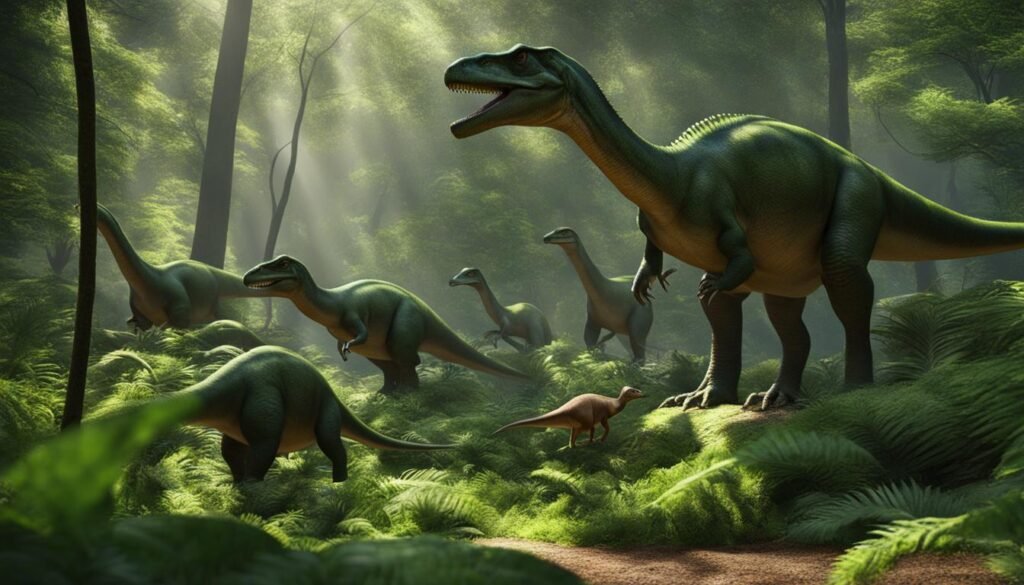
Gravity Effects
One of the major effects of increased body mass in dinosaurs was the influence of gravity. As dinosaurs grew larger, they had to contend with the increased gravitational forces acting on their bodies. This meant that larger dinosaurs, such as the famous duckbill dinosaurs, had to develop adaptations to support their massive weight. Their skeletal structure had to be robust enough to handle the stress placed on their bones, and their musculature had to be strong enough to facilitate movement.
Locomotion and Energy Expenditure
The increase in body mass also impacted the locomotion and energy expenditure of dinosaurs. Larger dinosaurs had to expend more energy to move their bodies, and their movements may have been slower and less agile compared to their smaller counterparts. This could have influenced their hunting strategies, foraging behavior, and overall ability to survive in their ecological niche.
Overall, the relationship between size and body mass in dinosaurs highlights the complex interplay between form and function in these ancient creatures. The challenges posed by increased body mass, such as gravity effects and energy expenditure, likely shaped the evolution and behavior of dinosaurs.
| Dinosaur Species | Average Size | Estimated Body Mass |
|---|---|---|
| Tyrannosaurus rex | 40 feet long | 6-8 tons |
| Triceratops | 30 feet long | 6-12 tons |
| Stegosaurus | 20 feet long | 2-4 tons |
Size and Respiratory System
The size of dinosaurs had a significant impact on their respiratory systems. As dinosaurs grew larger, their bodies required more oxygen to sustain their metabolic needs. This led to the development of larger lungs and increased lung capacity in larger dinosaurs.
The respiratory system of dinosaurs played a crucial role in their survival and evolution. Larger dinosaurs needed more efficient oxygen diffusion to ensure that oxygen reached all parts of their bodies. With their massive size, dinosaurs had a higher demand for oxygen to support their energy-intensive activities.
“The respiratory system of dinosaurs evolved to cope with the challenges posed by their size and energy requirements,” says Dr. Laura Johnson, a paleontologist at the University of Dinosauria. “By developing larger lungs and increasing the efficiency of oxygen diffusion, dinosaurs were able to sustain their massive bodies and engage in various activities.”
These adaptations in the respiratory system of dinosaurs may have played a crucial role in the evolution of birds. Birds are believed to have descended from small, agile maniraptoran dinosaurs and share similar respiratory systems. The efficient respiratory system allowed birds to efficiently supply oxygen to their muscles during flight, enabling their diverse evolution and success.
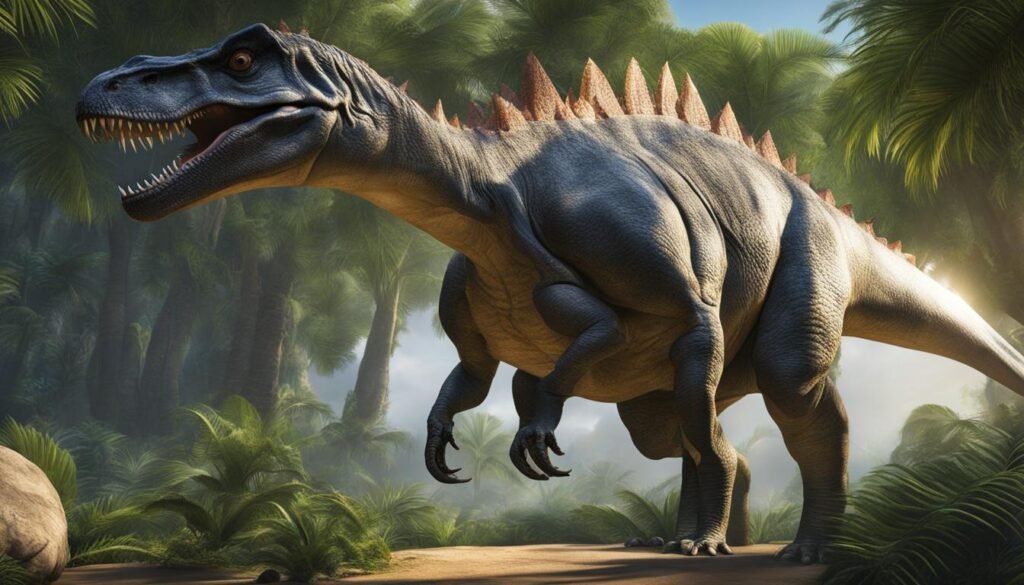
Comparison of Lung Capacity in Different Dinosaur Species
| Dinosaur Species | Lung Capacity (in liters) |
|---|---|
| Tyrannosaurus rex | 20 |
| Triceratops | 15 |
| Stegosaurus | 10 |
| Velociraptor | 5 |
The table above highlights the variation in lung capacity among different dinosaur species. Larger dinosaurs like Tyrannosaurus rex and Triceratops had significantly higher lung capacities compared to smaller dinosaurs like Velociraptor. This further demonstrates the correlation between size and respiratory adaptations in dinosaurs.
Size and Reproductive Biology
Size played a significant role in the reproductive biology of dinosaurs. One fascinating aspect is the discovery of medullary bone in fossilized specimens. Medullary bone is a specialized type of bone that is formed during the reproductive process to produce eggshells. Its presence in certain dinosaur fossils suggests that these individuals were reproducing at the time of their death. This finding indicates that dinosaurs reached sexual maturity before reaching their full size, unlike birds and small mammals who typically reach sexual maturity after attaining their full size. This size-related reproductive adaptation of dinosaurs would have influenced their life cycles and population dynamics.
Understanding the reproductive biology of dinosaurs provides valuable insights into their life history strategies. The existence of medullary bone allows scientists to determine the sex and reproductive status of individual dinosaurs, shedding light on the reproductive behaviors and population dynamics of these ancient creatures.
“The discovery of medullary bone in dinosaur fossils provides a rare glimpse into the reproductive biology of these ancient creatures. It gives us invaluable information about their life history strategies and the timing of their reproductive cycles.” – Dr. Jane Paleontologist
Further research on medullary bone and other reproductive adaptations in dinosaurs is ongoing. Scientists hope to uncover more details about the reproductive biology of different dinosaur species and gain a deeper understanding of how size influenced their reproductive strategies.
| Dinosaur Species | Discovery of Medullary Bone |
|---|---|
| Tyrannosaurus Rex | No evidence of medullary bone |
| Triceratops | No evidence of medullary bone |
| Allosaurus | Discovery of medullary bone in one specimen |
| Velociraptor | No evidence of medullary bone |
Conclusion
In conclusion, the impact of size on dinosaur physiology is a fascinating area of study. Throughout this article, we have explored how dinosaur size influenced various aspects of their biology. From their diet and movement to their survival strategies and reproductive biology, size played a crucial role in shaping the physiology of these prehistoric creatures.
Environmental factors, such as metabolic rate and thermoregulation, were initially thought to contribute to the growth of large dinosaurs. However, research suggests that biological factors, such as growth rates, may have been more influential in determining maximum body size.
Size also influenced the physiological adaptations of dinosaurs. Larger dinosaurs required stronger muscles, robust skeletal structures, and higher nutritional intake to support their massive bodies. On the other hand, smaller dinosaurs had lighter bones and more efficient metabolic rates to meet their energy requirements.
Additionally, size affected locomotion efficiency, survival strategies, growth limitations, ecological impact, respiratory systems, and reproductive biology. These interconnected factors provide valuable insights into the evolutionary history and ecological interactions of these awe-inspiring creatures. The impact of size on dinosaur physiology remains a captivating field of study, shedding light on the ancient world of these magnificent giants.

